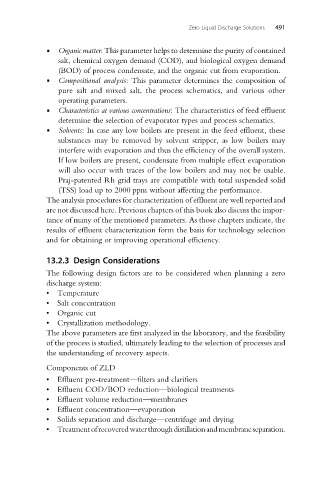Page 521 - Industrial Wastewater Treatment, Recycling and Reuse
P. 521
Zero Liquid Discharge Solutions 491
▪ Organic matter: This parameter helps to determine the purity of contained
salt, chemical oxygen demand (COD), and biological oxygen demand
(BOD) of process condensate, and the organic cut from evaporation.
▪ Compositional analysis: This parameter determines the composition of
pure salt and mixed salt, the process schematics, and various other
operating parameters.
▪ Characteristics at various concentrations: The characteristics of feed effluent
determine the selection of evaporator types and process schematics.
▪ Solvents: In case any low boilers are present in the feed effluent, these
substances may be removed by solvent stripper, as low boilers may
interfere with evaporation and thus the efficiency of the overall system.
If low boilers are present, condensate from multiple effect evaporation
will also occur with traces of the low boilers and may not be usable.
Praj-patented Rh grid trays are compatible with total suspended solid
(TSS) load up to 2000 ppm without affecting the performance.
The analysis procedures for characterization of effluent are well reported and
are not discussed here. Previous chapters of this book also discuss the impor-
tance of many of the mentioned parameters. As those chapters indicate, the
results of effluent characterization form the basis for technology selection
and for obtaining or improving operational efficiency.
13.2.3 Design Considerations
The following design factors are to be considered when planning a zero
discharge system:
• Temperature
• Salt concentration
• Organic cut
• Crystallization methodology.
The above parameters are first analyzed in the laboratory, and the feasibility
of the process is studied, ultimately leading to the selection of processes and
the understanding of recovery aspects.
Components of ZLD
• Effluent pre-treatment—filters and clarifiers
• Effluent COD/BOD reduction—biological treatments
• Effluent volume reduction—membranes
• Effluent concentration—evaporation
• Solids separation and discharge—centrifuge and drying
• Treatmentofrecoveredwaterthroughdistillationandmembraneseparation.

